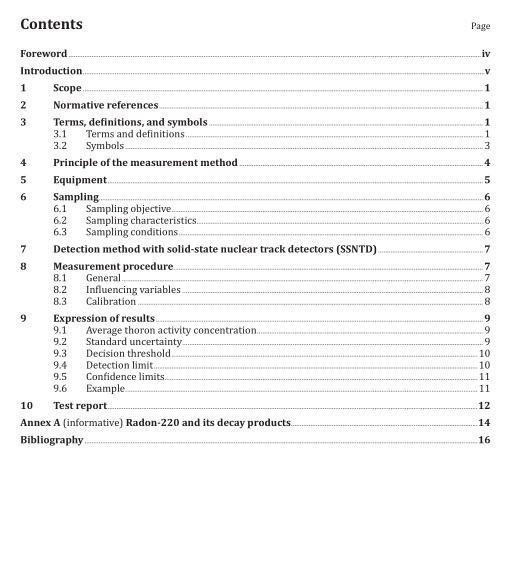ISO 16641:2014 pdf download.Measurement of radioactivity in the environment — Air — Radon 220: Integrated measurement methods for the determination of the average activity concentration using passive solid-state nuclear track detectors
4 Principle of the measurement method
The integrated measurement of the average radon-220 activity concentration using a solid-state nuclear track detector (SSNTD) is based on the following: [12]
— passive sampling using two chambers with different air-exchange rates during which the alpha particles, including those produced by the disintegration of radon-220, radon-222, and their decay products, transfer their energy by ionizing or exciting the atoms in the polymer or plastic. This energy transferred to the medium leaves areas of damage called “latent tracks”. Because of their different half-lives, radon-222 and radon-220 can be separated using these two chambers. In the high air-exchange rate chamber, both isotopes are detected. In the low air-exchange rate chamber, however, radon–222 is mainly detected with only a small quantity of radon-220 (see Figure 1); The high air-exchange rate should be set as high as possible so that the calibration factor of radon-220 is ideally the same as that of radon-222. On the contrary, the low air-exchange rate should be set as low as possible with a high diffusion barrier.
— transport of the exposed detectors to the laboratory for the appropriate chemical processing which transforms the latent tracks into “visible tracks” counted via an optical system. The number of these visible tracks per unit surface area is linked to the exposure value of the radon-220 and its decay products by the calibration factor defined for detectors in the same batch processed chemically and counted under the same conditions;
— determination of the radon-220 average activity concentration from the exposure value of both chambers and the sampling period.
5 Equipment
The apparatus includes the following.
Each of them is associated with a solid state nuclear track detector. Each closed accumulation chamberhas a filter through which the radon-220 and radon-222 diffuse. This filter is set to prevent access of the aerosols present in the air at the time of sampling, especially the solid radon-220 and radon-222 decay
products (see Figure 2).
The SSNTD shall come from the same sheet of plastic to avoid different results. Nevertheless each SSNTD batch is calibrated.
See ISO 11665-4.
5.3 An optical microscope and associated equipment, for scanning and counting the etched tracks.
6 Sampling
6.1 Sampling objective
The sampling objective is to place the measuring device, without interruption, in an air sample representative of the atmospheric medium under investigation. 6.2 Sampling characteristics The sampling is passive and is performed through a filtering medium. Depending on the air-exchange rate of the accumulation chamber, one or two radon isotopes can diffuse into the chamber. If the air- exchange rate is low, only radon-222 can diffuse into the chamber. If the air-exchange is high, both radon-222 and radon-220 can diffuse into the chamber. The sampling shall be performed in conditions that preclude clogging of the filtering medium, which would result in modified measuring conditions. If the filtering medium clogs there is a risk of the air in the chamber not being renewed.
6.3 Sampling conditions 6.3.1 Installation of sampling device The installation of the measuring device shall be carried out as specified in ISO 11665-1. In the specific case of an indoor measurement, the measuring device is installed as follows:
— in an area not directly exposed to solar radiation;
— away from a heat source (radiator, picture windows, electrical equipment, chimney, etc.); — away from traffic areas, doors and windows, and natural ventilation sources (it could, for example, be sited on an item of furniture like a shelf or sideboard);ISO 16641 pdf download.ISO 16641-2014 pdf download
